
Leiopython albertisii (White lipped python) breeding diary.
Welcome to the white lipped python breeding diary.
On this page I want to share relevant information from notes taken during breeding trials with this species along with my own thoughts and opinions about what seems to work and why.
I would suggest reading the main "Breeding Diaries" page if you have not, before reading this page as it contains information relevant to this page.
Click here to go to Breeding diaries main page.
Successfully breeding Leiopython albertisii has been a long journey for me beginning back in 1992.
Having kept but never successfully bred white lips between 1992 and the early 2000's when I lived in the UK, it was the one species I really wanted to try again with when I settled in Sweden in 2011.
My animals.
By the 2017 breeding season I had what I thought was a 2.2 group of albertisii. They were as follows,
2011 Captive born female purchased in 2011 as a 30g baby.
2014 Captive born female purchased late 2014 as a 139g juvenile.
2014 Captive born male (unrelated) purchased in 2014 as a 100g juvenile. Male (1)
2014 Captive born male purchased in 2014 as a 90g juvenile. Male (2).
2017-2018 just out of curiosity.
By the fall of 2017, although still quite small in size (900g) I thought that both males would be worth trying in with the 2011 female. This was unsuccessful for reasons that will become obvious in a moment. I still think however that there is some useful information and so will include a brief summary of what happened.
December 9th 2017.
After cooling the group (as mentioned on the main diary page) I first introduced male (1) into the females terrarium in the evening. I had removed the female and let the male explore her terrarium without her in there for 30 minutes. When I returned the female to the terrarium there was little interest between the two. The female would however push against the male every time they touched but there was no aggression shown between them. The pair were left together for three hours after lights out but showed little interest in each other and so the male was removed.
December 14th 2017.
Male (1) was added to the females terrarium whilst she was in it. Again little interest between them but female pushing the male again and no real aggression.
December 15th 2017.
Placed male (2) in with the female for a few hours. Again, no interest and no aggression.
December 17th 2017.
Placed male (1) in with female. No aggression and female was a little less pushy towards the male. They seemed a little more curious in each other. They were left in together for six nights and the male was removed December 23rd.
December 29th 2017.
The female refused a meal the previous night and male (1) was placed in with her again. Although no copulations were ever observed both animals would be curled up together often over the next week. The male was removed on Jan 5th 2018 and placed back in with the female Jan 10th 2018 for another two weeks and removed Jan 24th.
Although I am still unsure, I now believe the 2011 female to be a male. I had made the classic mistake of assuming the breeder had sexed the snake correctly and never checked myself. So out of curiosity I decided to probe her. She probed too deep for a female but still not so deep that I would say it definitely was a male. Feeling slightly pissed off I decided to stop the breeding trials and wait another year to get the other female to age. (Edit Feb 2022: the 2011 animal is now a proven male).
I think this information is interesting as this snake had been with two other males during breeding trials and there was no aggression show between any of the three animals. This is contradictory to a lot of reports of white lipped pythons (males and females) often showing a lot of aggression towards each other. This aggression has led people to suggest that white lips are mate selective. To date (2021) I have never witnessed any real aggression between any of my white lipped pythons when being housed together during breeding trials.
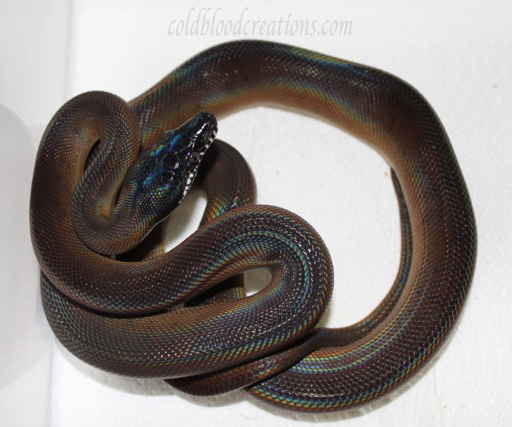
2018-2019 Success at last.
By November 2018 my other female (2) was 3 months shy of five years old. I had grown her slowly and her weight was 1600g. Although she looked quite small I thought I would give her a go. Both males at this time were a couple of months younger and around 1200g. Again temperatures were cycled as described on the main diaries page.
November 5th 2018.
Placed male (1) in with female (2) no aggression shown and no real interest in each other. Female spending a lot of time at the cool end of the terrarium (possible follicle development?) Removed male after a week on the November 18th and fed female a small meal.
November 26th 2018.
Placed the male back in with the female. The male is starting to show an interest in the female, tongue flicking her body and following her around the terrarium. However, each time he touches her too much with his body she wags her tail at him and pushes him away with her body. This behaviour continued for a number of nights but kept pair together as there was no real aggression shown.
December 7th 2018.
Dropped the night temp down to 20C and raised again the following night.
December 8th 2018.
Noticed the female everting her cloacae and wafting her tail in the air. Male showing more interest but still no copulation observed.
December 13th 2018.
Placed male (2) in the terrarium with male (1) and the female for about five hours to see if any male combat would spice things up a little. There was no male combat or any aggressive behaviour between the males. The female continued tail waggling at both males. I removed male (1) and left male (2) in with the female for a couple of weeks. No mating behaviour shown, no copulations seen and female still wagging her tail at the male (2).
January 23rd 2019.
Placed male(1) back in with female (2). No mating behaviour seen so removed male again early February.
My thoughts at this point were that maybe the female was still too young or a little small. I decided that I would be waiting another year and feeding her up a little more. I gave her a good sized meal (10%) on 11th February and again on 23rd and the 10th March. So this was larger three large meals at two week intervals. More than she would usually get.
March 19th 2019.
The female (2) was acting strangely, sitting out in the open on a large piece of cork bark during the daytime. She looked very full bodied with a very slight swelling mid body but had digested the previous meal. Although I thought the breeding season was over, this looked very much like early follicle development. After watching her sitting out in the open all day I decided to try male (1) with her again. Within 30 minutes of introducing the male to her terrarium the male started spurring the female. He was obviously way more excited than on any previous introductions and this time the female was more receptive with no tail wagging or body pushing. The pair mated and were locked up within two hours of introduction.
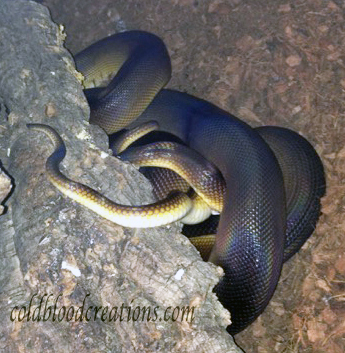
March 20th 2019.
Removed the male and tried feeding the female. She refused food.
March 21st 2019.
Placed male (1) back in with female (2) but male showed no interest so removed him again 23rd March.
March 27th 2019.
Placed male (1) back in with female and they were locked up again within an hour.
March 29th 2019.
Female looks slightly swollen lower third of her body. Possible ovulation? Removed male 31st March.
March 31st 2019.
Attempted to feed female and she refused food again.
April 4th 2019.
Female very swollen and looks almost definitely like ovulation!
April 24th 2019.
Female shed (post ovulation)
Between April 4th and 24th female was spending most days and nights hiding under cork bark at the warm side of the terrarium. After sloughing she started to move around a lot more than usual at night.
May 1st 2019.
Two plastic nest boxes filled with damp sphagnum moss were placed in the terrarium, one at the warm end and one at the cool end. She moved into the warm box almost immediately and remained there for the following days coming out only to drink.
May 23rd 2019.
Female was noticed coiled in the box with her head under her coils at 18:00. She started laying eggs at around 18:30. This was 29 days after post ovulation shed. The first egg out was small and looked infertile. The next egg out looked good with good vein development. A third egg was pushed out over the next five minutes or so. I covered up the box and placed it back in the terrarium until 20:00. She had now laid five good eggs and the slug, with one egg clearly visible still inside her. By 20:30 she had laid the last egg and I removed her from the eggs and soaked her in a water bath. Although obviously tired she was quite defensive when removing her from the eggs and bit a couple of times.

The after diary 2019.
Here is some more information.
The female weighed around 1600g when she mated. After egg laying her weight was 1200g.
The total clutch weight (6 good eggs 1 slug) was 350g.
The slug weighed 26g and the six good eggs weighed 53g-55g each giving an average egg weight of 54g.
The six good eggs were placed into two incubator boxes (3 eggs each box) on damp vermiculite and placed in the incubator at 30.5C.
The first egg started to pip around 18:00 on July 21st (day 60). It pipped quite low down on the egg. A little later the baby began to move around inside the egg and slit the egg nearer the top and stuck it's head out. I then transferred all the eggs on to damp moss. To say I was excited would be an understatement. Nearly 30 years after I first wanted to breed white lips I had realised the dream!

This initial excitement was a little short lived however. After placing the egg back in the incubator I did not see any more movement over the next hour and so decided to open up the egg a little. After not seeing any movement from the baby inside the egg I cut the top to reveal a dead baby.
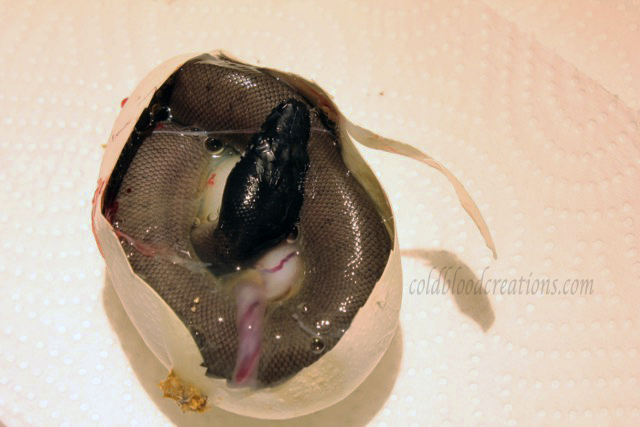
After removing the baby it could be seen that the umbilical chord had wrapped itself tightly around the baby snakes body. This probably played a role in the baby's death.


The baby weighed 31g and the egg sack weighed 7g. The total length of the baby was exactly 50cm.

The next morning July 22nd two more eggs had pipped and the fourth egg pipped that evening. The last two eggs pipped during the night and the following afternoon July 23rd all five remaining babies had come out of their eggs.
The five babies weighed 32g, 36g,35g 35g and 34g. Each baby was placed in it's own tub with damp moss as a substrate with a small water dish and was placed back into the incubator at 29C.
After they all had the first slough, roughly two weeks later they were removed from the incubator and placed in a rack. The set up was kept basic, using paper towel, a small water dish and a damp moss hide box placed towards the warm end of the tub.
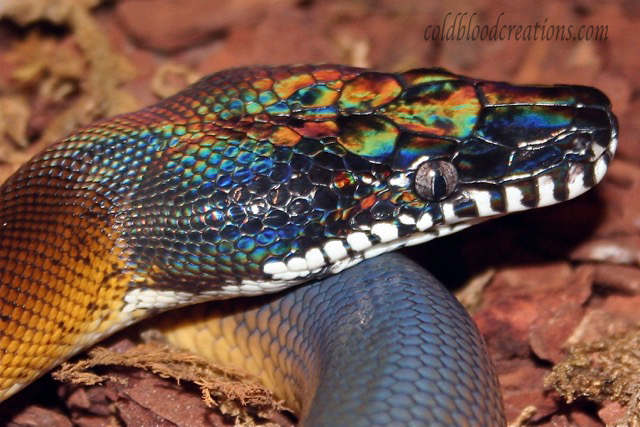
Some thoughts about the 2018/2019 season.
As I mentioned on the main breeding diaries page, obtaining young animals and gaining an understanding of their behaviour can help a great deal when it comes to breeding them. During the 2018/19 trials I had given up on breeding the white lips for the season. The normal temperature/humidity cycling has worked for me with a number of python species from the same region in previous years. I think the trigger to get the female white lip developing follicles was the higher than normal food intake. Had I not thought the females behaviour of laying out in the open during the day was unusual I might not have looked so closely and noticed the mid body swelling and so not tried the male again with her.
I also now believe that with white lips it is super important to introduce them at the right time to achieve mating behaviour. All other times the male was with the female she would tail wag at him and was not totally happy with him being near her.
Maybe with individuals in other collections this shows itself more aggressively and it is this miss-timing in introductions that leads some to assume they have a non compatible pair and that white lips are mate selective. Would these same animals behave in the same aggressive way if introduced when the female was in a follicle cycle and more receptive to a male? I think possibly not.
At this time I was keeping the female on a bark chip substrate in a simple set up with cork bark hides and damp moss hide/nest boxes. She was doing very well and so I continued using this set up for her. I gave her a season without breeding in 2019/20 but was excited about manipulating her food intake a little more heavily the following season to see if this might help confirm the possibility of food intake being an important trigger in this species.
Breeding diary 2020/2021 season.
By May 2020 the female had put on some more size and now weighed 2000g. Since the previous breeding, I had been feeding her roughly 10% size meals at roughly three week intervals. In the lead up to dropping temperatures in November.
I increased her food intake by offering meals 10% at one week intervals from mid September to early October.
As I do every year, I started to lower night time temperatures in the beginning of November.
November 5th 2020.
Placed the male in with female to see behaviour. Female was not receptive, with tail wagging and everting her cloacae at the male. Removed the male a couple of days later.
November 14th 2020.
Noticed the female sitting out in the open again as she had done in 2019. She looked a little full bodied but no really obvious swelling.
November 15th 2020.
Introduced the male to the females terrarium, no interest shown by either animal. Removed the male November 18th after not witnessing any interest between the two snakes. The female was still spending a lot of her time out in the open however in unusual positions.

These two images show the female looking full bodied and showing possible early signs of follicle development. She spent a number of days out in the open resting in unusual positions.
This is behaviour she does not show at any other time of the year and I now take this behaviour as an early indication this female is starting follicle development.
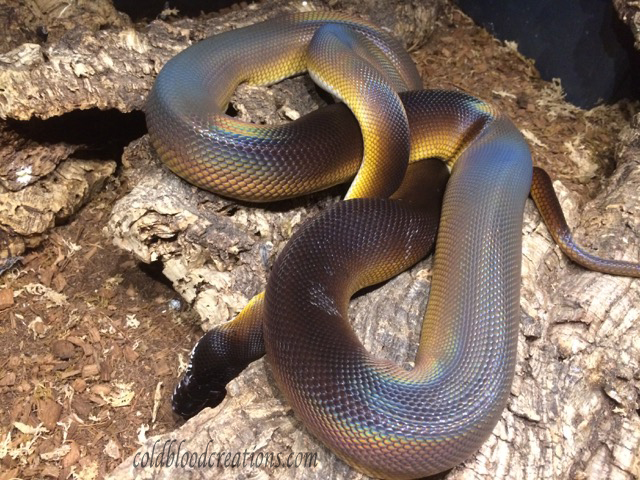
November 29th 2020.
The night time temperatures were now down to 22C. Placed the male in with the female in the afternoon. Both snakes were found locked up the following morning, 30th November and remained locked up for a couple of hours.
December 1st 2020.
Both snakes were hiding and didn't move from their respective hiding spots within the terrarium.
December 2nd 2020.
Removed male.
December 12th 2020.
Both male and female were given a small meal.
December 16th 2020.
Male re-introduced to females terrarium. Male went straight into the females hide box with her and both animals came out in the evening with the male spurring the female. The female now looked very swollen mid body. Both were locked up later that night.
December 17th 2020.
Both animals were curled up together in the morning and female moved into a hide box during the afternoon. Male moved into females hide box with her after lights out.
December 18th 2020.
Male was hiding under cork bark and female was in her hide box and both remained like this all day and following night.
December 19th 2020.
Removed male and palpated female. Female has large easy to feel follicles and managed to count what I believe is 10 or so.
December 23rd 2020.
Female has been sitting in the warm hide box since the 19th December. Added male again. He went straight into the hide with the female and I didn't see either come out from hide box until 27th December when the male came out. Removed male from terrarium.
December 29th 2020.
Female moved to the cooler hide box. Placed male back in the terrarium and he went straight into the hide box with her again. He once again remained with the female several days in the hide box until 2nd January 2021. Male was removed 2nd January.
January 5th 2021.
Female is now hiding under a cork slab at night that sits directly above the heat panel from the terrarium below it and gets around 26C heat throughout the night. She looks very swollen, possible ovulation? She sits under the cork bark at night and returns to her hide box at the warm end of the terrarium during the day.
January 28th 2021.
Female had what I assume was her post ovulation shed.
March 1st 2021.
Female started laying eggs around 17:00 and finished around 19:30 having laid 10 good looking eggs 31 days after post ovulation shed. Nine eggs had good vein development and one was questionable.
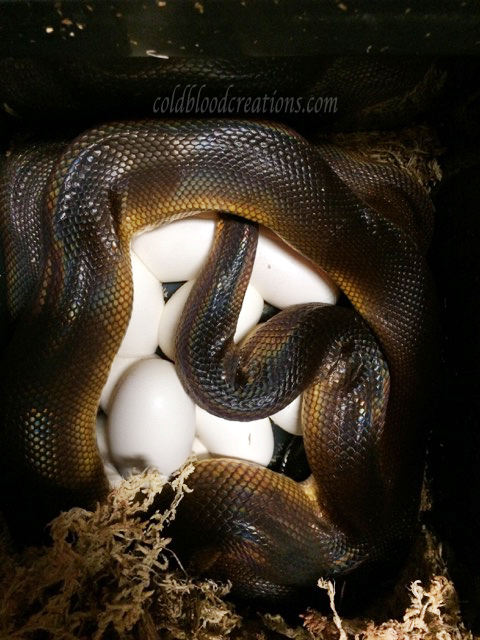
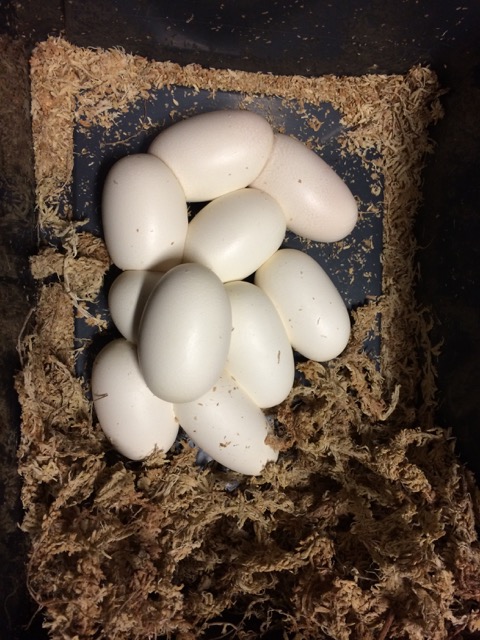
The after diary 2021.
The female weighed 2300g prior to egg laying. Once again the female was removed from the clutch and given a bath to remove most of the eggs scent and returned to her terrarium.
The eggs were incubated as in 2019 in damp vermiculite at 30.5C.
The eggs ranged from 49g to 56g giving an average over the ten eggs of 53g.
These two images taken on 26th March show the egg size of white lips compared to Green tree python eggs (smaller of the two). In the second image you can see the questionable white lip egg starting to go bad after three weeks.


The first egg pipped May 8th after 69 days incubation. All nine good eggs hatched producing strong babies.
Some thoughts about the 2020/2021 season.
I think the most interesting observation from these two breeding's is that they happen at different times in the year. From egg laying May 23rd in 2019 to March 1st in 2021 which is 81 days difference in the space of two years.
Looking at this timeframe another way, the first observed mating was March 19th in 2019 and November 29th in 2020 which is 109 days difference.
This would lead me to think that night time cooling doesn't seem to play such a big role in the females reproductive cycle as previously thought. In 2021 I had quite literally only lowered my night temperatures fully, a week prior to first observed mating. In 2019 the first observed mating took place after the entire three month cooling cycle had been completed.
As with night temperature drops, I don't think that the natural light cycle of the room is triggering the female to a huge extent either.
The thing that stands out to me, is the fact that in the weeks just prior to follicle development, and first observed mating's, in both 2019 and 2020, was that the female had quite a sharp increase in food intake.
This leads me to believe that food intake, and by definition food cycling, play a far greater role in the females reproductive state than the more commonly recognised technique of temperature cycling. I think that temperature cycling still plays a role in propagating this species and would not change the way I cycle my room or terrariums but I do not think it is the most important ingredient.

I also find it interesting that even when two males were placed in together with a female there was no male combat or aggression shown.
I do think it is some sort of chemical cue that the males are getting from the females when the females are receptive. The change in males behaviour is quite obvious between when the female is receptive and when she is not. Showing mild interest when the female is not receptive to being very excited, tongue flicking, spurring and attempting to copulate within minutes of being introduced to a receptive female would suggest a strong chemical signal.
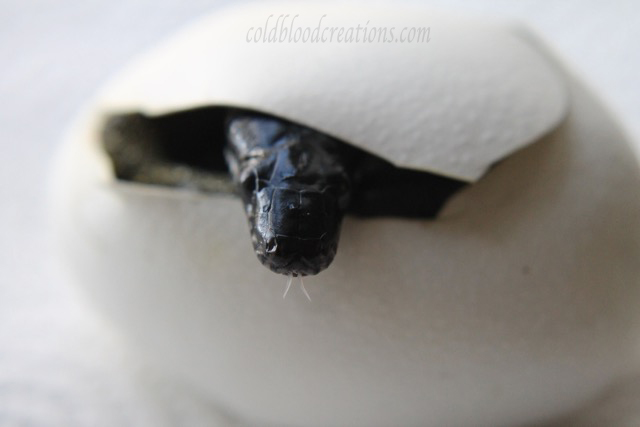
If the female is not in a receptive cycle then maybe this is where some of the reported aggression in pairing this species comes from. Although my pairings were successful, the female was not overly accepting of the male when she was not receptive. Maybe in other individuals this non acceptance could be shown more aggressively.
This makes me wonder if animals that are reportedly quite aggressive towards each other, might still be a compatible pair if introduced at the relevant time during follicle growth.
This also brings me back to a point I made on the main breeding diaries page, that getting younger animals and learning there behaviours in order to spot any unusual behaviour is quite important with this species in understanding when that relevant time to pair animals is.

I hope some of this information helps others to reproduce these fantastic pythons.
This has been an absolutely amazing 30 year journey for me.
Could I have bred white lips in the 1990's ? Probably not.
I didn't have the long term patience in my twenties back then.
Nowadays I get a huge amount of enjoyment raising animals from babies to sexually maturity and understanding their behaviours before attempting to breed them. I think that the white lipped python is a species that lends itself well to this mind set.
These pythons don't seem to be a quick fix species and seriously attempting to breed them will most likely pull you in for a minimum of five or six years, but having siad that, they are so definitely worth the effort.
